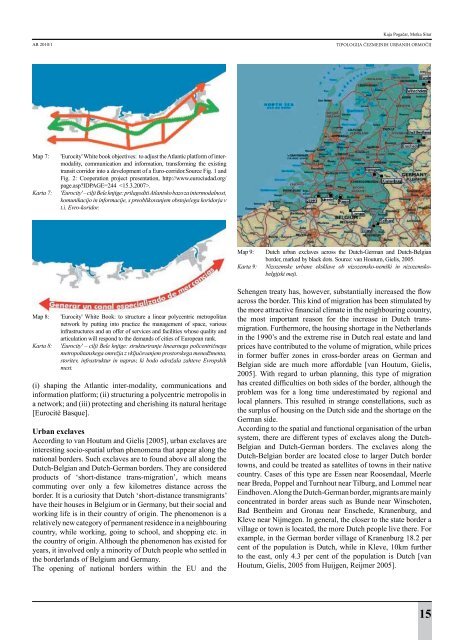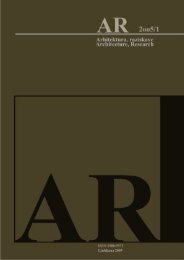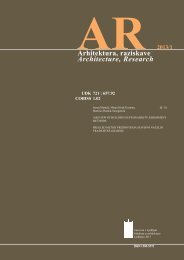AR 2010/1 - Fakulteta za arhitekturo - Univerza v Ljubljani
AR 2010/1 - Fakulteta za arhitekturo - Univerza v Ljubljani
AR 2010/1 - Fakulteta za arhitekturo - Univerza v Ljubljani
You also want an ePaper? Increase the reach of your titles
YUMPU automatically turns print PDFs into web optimized ePapers that Google loves.
Kaja Pogačar, Metka Sitar<br />
<strong>AR</strong> <strong>2010</strong>/1<br />
TIPOLOGIJA ČEZMEJNIH URBANIH OBMOČIJ<br />
Map 7:<br />
Karta 7:<br />
'Eurocity' White book objectives: to adjust the Atlantic platform of intermodality,<br />
communication and information, transforming the existing<br />
transit corridor into a development of a Euro-corridor.Source Fig. 1 and<br />
Fig. 2: Cooperation project presentation, http://www.eurociudad.org/<br />
page.asp?IDPAGE=244 .<br />
'Eurocity' – cilji Bele knjige: prilagoditi Atlantsko bazo <strong>za</strong> intermodalnost,<br />
komunikacijo in informacije, s preoblikovanjem obstoječega koridorja v<br />
t.i. Evro-koridor.<br />
Map 9:<br />
Karta 9:<br />
Dutch urban exclaves across the Dutch-German and Dutch-Belgian<br />
border, marked by black dots. Source: van Houtum, Gielis, 2005.<br />
Nizozemske urbane eksklave ob nizozemsko-nemški in nizozemskobelgijski<br />
meji.<br />
Map 8:<br />
Karta 8:<br />
'Eurocity' White Book: to structure a linear polycentric metropolitan<br />
network by putting into practice the management of space, various<br />
infrastructures and an offer of services and facilities whose quality and<br />
articulation will respond to the demands of cities of European rank.<br />
'Eurocity' – cilji Bele knjige: strukturiranje linearnega policentričnega<br />
metropolitanskega omrežja z vključevanjem prostorskega menedžmenta,<br />
storitev, infrastruktur in naprav, ki bodo odražala <strong>za</strong>hteve Evropskih<br />
mest.<br />
(i) shaping the Atlantic inter-modality, communications and<br />
information platform; (ii) structuring a polycentric metropolis in<br />
a network; and (iii) protecting and cherishing its natural heritage<br />
[Eurocitè Basque].<br />
Urban exclaves<br />
According to van Houtum and Gielis [2005], urban exclaves are<br />
interesting socio-spatial urban phenomena that appear along the<br />
national borders. Such exclaves are to found above all along the<br />
Dutch-Belgian and Dutch-German borders. They are considered<br />
products of ‘short-distance trans-migration’, which means<br />
commuting over only a few kilometres distance across the<br />
border. It is a curiosity that Dutch ‘short-distance transmigrants’<br />
have their houses in Belgium or in Germany, but their social and<br />
working life is in their country of origin. The phenomenon is a<br />
relatively new category of permanent residence in a neighbouring<br />
country, while working, going to school, and shopping etc. in<br />
the country of origin. Although the phenomenon has existed for<br />
years, it involved only a minority of Dutch people who settled in<br />
the borderlands of Belgium and Germany.<br />
The opening of national borders within the EU and the<br />
Schengen treaty has, however, substantially increased the flow<br />
across the border. This kind of migration has been stimulated by<br />
the more attractive financial climate in the neighbouring country,<br />
the most important reason for the increase in Dutch transmigration.<br />
Furthermore, the housing shortage in the Netherlands<br />
in the 1990’s and the extreme rise in Dutch real estate and land<br />
prices have contributed to the volume of migration, while prices<br />
in former buffer zones in cross-border areas on German and<br />
Belgian side are much more affordable [van Houtum, Gielis,<br />
2005]. With regard to urban planning, this type of migration<br />
has created difficulties on both sides of the border, although the<br />
problem was for a long time underestimated by regional and<br />
local planners. This resulted in strange constellations, such as<br />
the surplus of housing on the Dutch side and the shortage on the<br />
German side.<br />
According to the spatial and functional organisation of the urban<br />
system, there are different types of exclaves along the Dutch-<br />
Belgian and Dutch-German borders. The exclaves along the<br />
Dutch-Belgian border are located close to larger Dutch border<br />
towns, and could be treated as satellites of towns in their native<br />
country. Cases of this type are Essen near Roosendaal, Meerle<br />
near Breda, Poppel and Turnhout near Tilburg, and Lommel near<br />
Eindhoven. Along the Dutch-German border, migrants are mainly<br />
concentrated in border areas such as Bunde near Winschoten,<br />
Bad Bentheim and Gronau near Enschede, Kranenburg, and<br />
Kleve near Nijmegen. In general, the closer to the state border a<br />
village or town is located, the more Dutch people live there. For<br />
example, in the German border village of Kranenburg 18.2 per<br />
cent of the population is Dutch, while in Kleve, 10km further<br />
to the east, only 4.3 per cent of the population is Dutch [van<br />
Houtum, Gielis, 2005 from Huijgen, Reijmer 2005].<br />
15

















